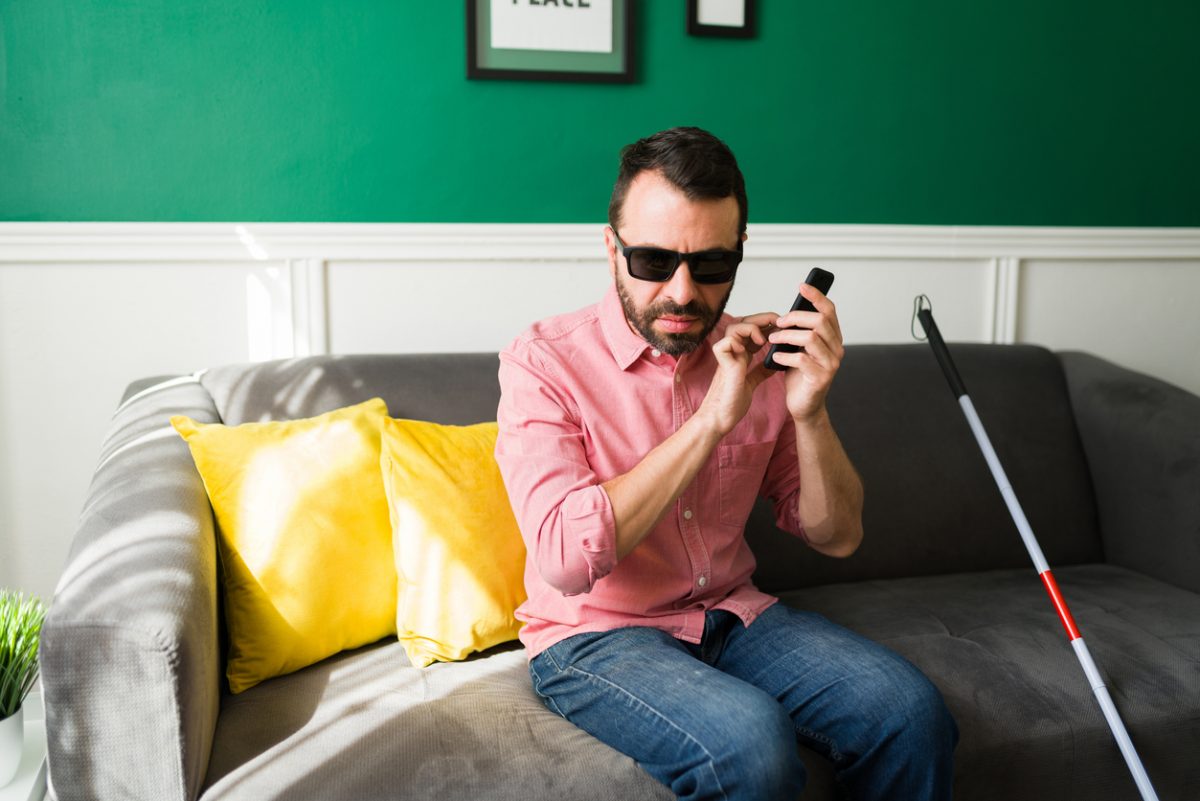Because this piece does not have an abstract, we have provided for your benefit the first 3 sentences of the full text.
Every day, people are reliant on smartphones to stay connected, organized, and entertained. Every year, smartphones are equipped with more processing power, digital storage, and sensors. As a result of their growing ubiquity and technical advances, there are now exciting opportunities for leveraging these devices in clinical health research, care, and intervention.
This work may not be copied, distributed, displayed, published, reproduced, transmitted, modified, posted, sold, licensed, or used for commercial purposes. By downloading this file, you are agreeing to the publisher’s Terms & Conditions.


Opportunities for Smartphones in Clinical Care:
The Future of Mobile Mood Monitoring
Every day, people are reliant on smartphones to stay connected, organized, and entertained. Every year, smartphones are equipped with more processing power, digital storage, and sensors. As a result of their growing ubiquity and technical advances, there are now exciting opportunities for leveraging these devices in clinical health research, care, and intervention. Collectively, these opportunities are often referred to as the emergent "mobile health" or mHealth trend. Here, we briefly discuss 3 areas where smartphones can make a significant impact (ambulatory assessment, behavior monitoring, understanding and predicting outcomes), using a system that we have developed—Emotion Sense—as a case study. We also caution about some of the limitations of this technology.
Ambulatory Assessment
Periodic assessments of long-term health conditions during spaced laboratory or clinic visits provide only a coarse-grained view of individuals’ range of psychological experiences. The information recalled during these sessions is subject to various biases, from misremembering, to reframing, to forgetting. In an effort to overcome such limitations, researchers have developed a form of ambulatory assessment known as "experience sampling," in which individuals are prompted periodically throughout the day to report their current state, symptoms, or surroundings.
Smartphones offer a useful platform for ambulatory assessment because people carry their phones with them most of the time and can therefore complete momentary assessments anywhere. People are accustomed to taking a few moments to check their e-mail, text messages, or social media feeds, so taking a moment to complete a brief survey is no more disruptive. Furthermore, by implementing ambulatory assessment as a smartphone application, geographically distributed participants or patients can simply download and install an application onto their mobile device, avoiding the need to physically go to a laboratory or clinic.
The information obtained from ambulatory assessments can be valuable for clinical monitoring of patients with long-term health conditions, both to augment the information available to clinicians and to trigger early warning systems. For example, information about mood states and how they change from moment to moment may predict the future course of mental disorders, such as depression.1,2 Paired with real-time data analysis, regular data about patients’ momentary states may help clinicians identify patients with symptoms that are quickly taking a turn for the worse.
Behavior Monitoring
The value of smartphones in both clinical and research contexts goes beyond momentary self-report assessments. Indeed, standard off-the-shelf smartphones have built-in sensors that are capable of passively detecting information that can provide context for a person’s momentary assessments. For example, the accelerometer can detect physical activity, the Global Positioning System (GPS) can detect location, and the phone and SMS logs (short message service, also known as text messaging) can detect social activity. The sensors in smartphones can collect this information nearly continuously, without interrupting individuals as they go about their daily activities. Thus, smartphones offer a platform for passively collecting objective information about clinically relevant behaviors at a granular level for a long period of time.
The integration of momentary assessments and sensor data has tremendous potential for clinical research and treatment. For example, momentary assessments of depression and anxiety, combined with behavioral data from GPS, accelerometer, and anonymized call logs, could reveal psychological and behavioral patterns of clinical relevance. By combining momentary assessments and sensor data, we found with Emotion Sense (http://emotionsense.org/) that self-reported mood is related to sensed physical activity, and other researchers have found that self-reported mood is related to sensed sociability and sensed sleep.3 These data also allow analysis of behavior change: students’ deteriorating well-being over the course of a university semester can be seen in self-reports of decreased mood but can also be detected through decreases in sensed sociability and sensed physical activity.4 In a clinical context, information about the links between psychological states and behavior could be used to inform treatment as well as monitor patients’ progress.
Understanding and Predicting Outcomes
The vast quantity of data sourced from smartphones (via self-reports and sensors) has the potential to deepen our understanding of the ways in which contextual factors contribute to clinical outcomes. However, effectively utilizing the data for understanding and predicting outcomes requires analytic techniques not commonly used in the health and behavioral sciences. Machine learning is an analytic strategy that can uncover patterns of behavior, examine associations that may otherwise be too complex to investigate manually, and use the knowledge gained to predict health outcomes in real time. Machine-learning algorithms become smarter with more data, so the massive amount of information collected via mobile sensing creates unprecedented potential for insight.
Machine-learning algorithms can be trained to classify data into defined categories (eg, depressed, not depressed). To do so, sensing and self-report data from people that fall in the different categories (eg, data from patients who are known to be depressed and from patients who are known not to be depressed) are used to train the model. After training, machine-learning algorithms can be used to predict which category is the most likely for any given person. For example, machine-learning algorithms can be trained to classify a person’s pattern of behavior as matching one of several trajectories of depressive symptoms (eg, minimal, mild, moderate) detected and described in past research.5,6 Upon identifying that the user is on a negative trajectory, the phone could alert the user, which might be sufficient to help the user break out of a negative cycle of behavior.7
Case Study: Emotion Sense
In our own work, we have capitalized on the trends described above to study the contextual factors related to daily fluctuations in mood, using smartphone-based experience sampling, sensing, and machine learning. More specifically, we have built a system called Emotion Sense that combines all 3 of these capabilities, and we are now applying this system to health contexts that focus on both measurement and intervention. We have used the system to build smartphone apps that, while tailored to specific domains, all share the same underlying methodology for active and passive data capture.
The first app we built, which has the same name as the system, focuses on measuring subjective well-being. It uses experience sampling to collect self-reported mood, allows users to complete a battery of psychological assessments (eg, related to personality and subjective health), and passively tracks a range of daily behaviors via the smartphone’s sensors: physical activity (as measured by the accelerometer on users’ phones), sociability (via calling and texting logs), and mobility (via coarse-grained location traces). This app fosters engagement by providing users with basic feedback about the relationships between the self-report and sensor data (eg, how they tend to feel when they are at home vs at work). To date, this app has been downloaded over 38,000 times worldwide, demonstrating how this research and data-capture methodology can be used to collect very large-scale data from global populations.
More recently, we combined experience sampling and sensor data with machine learning to automate and personalize a structured smoking-cessation intervention, by creating an app called "Q Sense" using the Emotion Sense system. Prospective quitters train the app before their quit date. By completing a short assessment each time they smoke, they help the system learn about the emotional, social, and contextual factors that are linked to their smoking; in exchange, they receive feedback and support that prepares them for their quit attempt. After users’ quit date arrives, the app begins to take action using the smoking pattern data it has received. The app can detect when the user enters locations where they have historically smoked, and, based on the user’s self-reports, build a profile of the stress levels, cravings, and social contexts that are typically associated with that location. These data are then used to deliver support messages that have been tailored to the individual’s specific behavioral patterns and preferences.
Outlook and Limitations
Although mobile apps hold great potential for studying psychological states over time, they do have limitations, ranging from cultural variations in the usage of these devices (eg, older adults may not own or be willing to use smartphones in this manner) to the quality of the data that they can generate. If, for example, people find the momentary assessments too long, the frequency of assessments too intrusive, or the application too difficult to use, it is unlikely they will complete momentary self-report surveys regularly. This risk can be minimized by making the app engaging (eg, introducing "gamification" features) and by providing feedback to the users, so they find it a useful tool for self-knowledge. Furthermore, the quality of data sourced from sensors is dependent on users having the phone in their possession—the accelerometer will not record physical activity if the phone is left on the desk during an afternoon walk. It is also unlikely that users will keep a mobile sensing application on their device if the app consumes too much battery power (eg, as a result of trying to sense data too often).
In summary, smartphone applications are ideal for studying psychological and behavioral processes over time through a combination of ambulatory assessment and mobile sensing. Machine-learning algorithms that uncover patterns of behavior can feed into customized interventions that could promote positive behavioral change. The possibility of harnessing technology to learn about and monitor the factors that affect the daily lives and symptoms of patients has never been greater. The primary challenge is how to best fit these technologies into the cycle of care.
Submitted: April 15, 2015; accepted May 7, 2015.
Potential conflicts of interest: Drs Lathia, Mascolo, and Rentfrow have equity ownership in Emotion Sense Mobile Ltd, which is developing products related to the reported research. Dr Sandstrom has no conflicts of interest to disclose.
Funding/support: The Emotion Sense research was supported by the UK Engineering and Physical Sciences Research Council’s UBhave project (Ubiquitous and Social Computing for Positive Behaviour Change, ref. EP/I032673/1); its open-source software can be accessed via http://emotionsense.org/.
REFERENCES
1. Höhn P, Menne-Lothmann C, Peeters F, et al. Moment-to-moment transfer of positive emotions in daily life predicts future course of depression in both general population and patient samples. PLoS ONE. 2013;8(9):e75655. PubMed doi:10.1371/journal.pone.0075655
2. Wichers M. The dynamic nature of depression: a new micro-level perspective of mental disorder that meets current challenges. Psychol Med. 2014;44(7):1349-1360. PubMed doi:10.1017/S0033291713001979
3. Moturu ST, Khayal I, Aharony N, et al. Using Social Sensing to Understand the Links Between Sleep, Mood, and Sociability. Washington, DC: IEEE Soc Comput; 2011:208-214. doi:10.1109/PASSAT/SocialCom.2011.200
4. Wang R, Chen F, Chen Z, et al. StudentLife: Assessing Mental Health, Academic Performance and Behavioral Trends of College Students Using Smartphones. New York, NY: ACM Pervasive and Ubiquit Comput; 2014:3-14. doi:10.1145/2632048.2632054
5. Clapp JD, Grubaugh AL, Allen JG, et al. Modeling trajectory of depressive symptoms among psychiatric inpatients: a latent growth curve approach. J Clin Psychiatry. 2013;74(5):492-499. PubMed doi:10.4088/JCP.12m07842
6. Pfeiffer PN, Bohnert KM, Zivin K, et al. Mobile health monitoring to characterize depression symptom trajectories in primary care. J Affect Disord. 2015;174:281-286. PubMed doi:10.1016/j.jad.2014.11.040
7. Kauer SD, Reid SC, Crooke AH, et al. Self-monitoring using mobile phones in the early stages of adolescent depression: randomized controlled trial. J Med Internet Res. 2012;14(3):e67. PubMed doi:10.2196/jmir.1858
aDepartment of Psychology and bComputer Laboratory, University of Cambridge, Cambridge, United Kingdom
*Corresponding author: Peter J. Rentfrow, PhD, Department of Psychology, University of Cambridge, Cambridge CB2 3RQ, United Kingdom ([email protected]).
J Clin Psychiatry 2016;77(2):e135-e137
dx.doi.org/10.4088/JCP.15com10054
© Copyright 2016 Physicians Postgraduate Press, Inc.
This PDF is free for all visitors!




